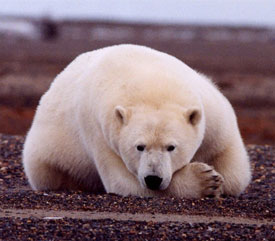Is Global Warming Killing Polar Bears? — WSJ
Rhett A. Butler, mongabay.com
December 14, 2005
Today The Wall Street Journal ran an article asking “Is Global Warming Killing the Polar Bears?” The article cited several recent studies that suggest polar bears are increasingly under threat from receding ice and warming temperatures.
Drowned polar bears are being found for the first time by researchers in Alaska, who speculate that greater distances between ice sheets could be taking a toll on the bears. While bears are capable of swimming long distances — up to 60 miles (100 km) without stopping — it is conceivable that they could suffer from exhaustion during an unexpectedly arduous swim.
The loss of ice also makes it more difficult for bears to find food.
“Polar bears must wait out the summer melt season on land, using their stored fat until they can return to the ice. But if winter recovery and sea ice extent continue to decline, how will these beasts survive?” asks Roger Barry, director of the National Snow and Ice Data Center (NSIDC).
Unlike grizzly bears, polar bears aren’t adapted to hunting land animals like caribou, instead feeding primarily on seals. However, recent aerial surveys by the U.S. Fish and Wildlife Service show that, over the past five years, polar bears are changing their habits and spending more time on land, congregating on beaches and scavenging whale carcasses.
 Courtesy of the U.S. Fish and Wildlife Service |
Jim Carlton of The Wall Street Journal continues, “Scientists measured the distances from where the bears were gathered to the nearest ice sheets at sea and found this correlation: The farther the ice was from shore, the larger the number of bears were found on land.”
Extrapolating from these developments, some scientists believe that polar bears could be extinct in the wild within the next century. While the last survey in 1997 suggested that polar bears in Alaska were not endangered, next year’s update might come to a different conclusion. Scientists estimate there are currently 20,000 to 25,000 polar bears world-wide.
Related articles
Polar bears hold key to understanding health risk of environmental pollutants
Polar bears and people, at the chilly top of the Arctic’s food chain, risk consuming a smorgasbord of industrial pollutants that have seeped into their habitat and pose potential health hazards. Now a University of Florida researcher, aiming to better understand just how dangerous the chemicals might be to humans, has zeroed in on how effectively polar bears are able to rid themselves of environmental toxins consumed in the food they eat. It turns out the bears can completely eliminate only one of five of the classes of industrial contaminants they are exposed to, a finding that’s bad news for the bears and other species who share their environment.
Decline of Arctic sea ice increases: For the fourth consecutive year, NSIDC and NASA scientists using satellite data have tracked a stunning reduction in arctic sea ice at the end of the northern summer. The persistence of near-record low extents leads the group to conclude that Arctic sea ice is likely on an accelerating, long-term decline.